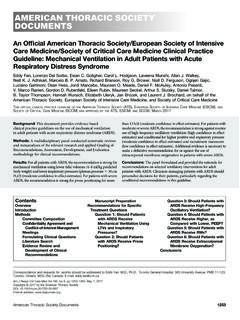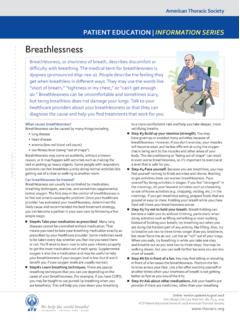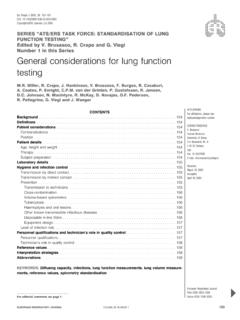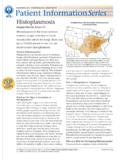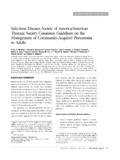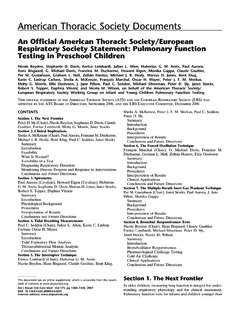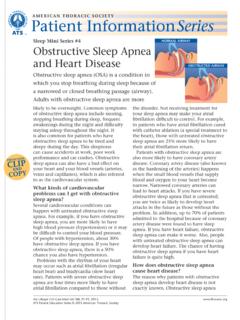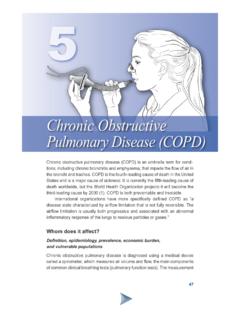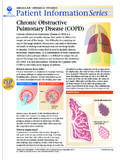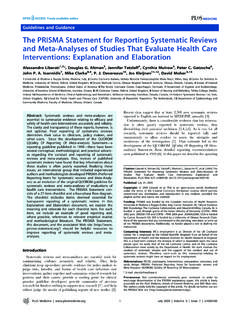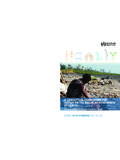Transcription of Official ERS/ATS clinical practice guidelines: noninvasive ...
1 Official ERS/ATS clinical practiceguidelines: noninvasive ventilation foracute respiratory failureBram Rochwerg1, Laurent Brochard2,3, Mark W. Elliott4, Dean Hess5,Nicholas S. Hill6, Stefano Nava7and Paolo Navalesi8(members of the steeringcommittee); Massimo Antonelli9, Jan Brozek1, Giorgio Conti9, Miquel Ferrer10,Kalpalatha Guntupalli11, Samir Jaber12, Sean Keenan13,14, Jordi Mancebo15,Sangeeta Mehta16and Suhail Raoof17,18(members of the task force)@ERSpublicationsERS/ATS evidence-based recommendations for the use of noninvasive ventilation in acute this article as:Rochwerg B, Brochard L, Elliott MW,et al. Official ERS/ATS clinical practiceguidelines: noninvasive ventilation for acute respiratory Respir J2017; 50: 1602426 [ ].ABSTRACTN oninvasive mechanical ventilation (NIV) is widely used in the acute care setting for acuterespiratory failure (ARF) across a variety of aetiologies.
2 This document provides European RespiratorySociety/American Thoracic Society recommendations for the clinical application of NIV based on themost current guideline committee was composed of clinicians, methodologists and experts in the field ofNIV. The committee developed recommendations based on the GRADE (Grading, Recommendation,Assessment, Development and Evaluation) methodology for each actionable question. The GRADEE vidence to Decision framework in the guideline development tool was used to generate number of topics were addressed using technical summaries without recommendations and these arediscussed in the supplementary guideline committee developed recommendations for 11 actionable questions in a PICO (population intervention comparison outcome) format, all addressing the use of NIV for various aetiologies of ARF.
3 Thespecific conditions where recommendations were made include exacerbation of chronic obstructive pulmonarydisease, cardiogenic pulmonary oedema,de novohypoxaemic respiratory failure, immunocompromisedpatients, chest trauma, palliation, post-operative care, weaning and document summarises the current state of knowledge regarding the role of NIV in ARF. Evidence-based recommendations provide guidance to relevant article has supplementary material available from : Dec 09 2016 | Accepted after revision: June 15 2017 This document was endorsed by the ERS Executive Committee in July 2017 and approved by the ATS Board ofDirectors in June guidelines published by the European Respiratory Society (ERS) incorporate data obtained from a comprehensiveand systematic literature review of the most recent studies available at the time.
4 Health professionals are encouraged totake the guidelines into account in their clinical practice . However, the recommendations issued by this guideline maynot be appropriate for use in all situations. It is the individual responsibility of health professionals to consult othersources of relevant information, to make appropriate and accurate decisions in consideration of each patient s healthcondition and in consultation with that patient and the patient s caregiver where appropriate and/or necessary, and toverify rules and regulations applicable to drugs and devices at the time of of interest: Disclosures can be found alongside this article at ERS 2017 Respir J 2017; 50: 1602426 TASK FORCE REPORTERS/ATS GUIDELINESA ffiliations:1 Dept of Medicine, Dept of clinical epidemiology and biostatistics , McMaster University,Hamilton, ON, Division of Critical Care Medicine, University of Toronto, Toronto,ON, Research Centre and Li Ka Shing Knowledge Institute, St Michael s Hospital, Toronto,ON, of Respiratory Medicine, St James s University Hospital, Leeds, CareDept, Massachusetts General Hospital and Dept of Anesthesia, Harvard Medical School, Boston, MA, of Pulmonary, Critical Care and Sleep Medicine, Tufts Medical Center, Boston, MA, ofSpecialistic, Diagnostic and Experimental Medicine, Respiratory and Critical Care, Sant Orsola MalpighiHospital, Alma Mater Studiorum, University of Bologna, Bologna, and Intensive Care, Deptof Medical and Surgical Sciences.
5 Magna Graecia University, Catanzaro, of Anesthesiology andIntensive Care Medicine, Catholic University of Rome, A. Gemelli University Hospital, Rome, ofPneumology, Respiratory Institute, Hospital Clinic, IDIBAPS, University of Barcelona and CIBERES, Barcelona, of Pulmonary and Critical Care Medicine, Baylor College of Medicine, Houston, TX, Critical Care Medicine and Anesthesiology (DAR B), Research Unit INSERM U1046, Saint Eloi UniversityHospital and Montpellier School of Medicine, Montpellier, of Critical Care Medicine,University of British Columbia, Vancouver, BC, of Critical Care Medicine, Royal ColumbianHospital, New Westminster, BC, de Medicina Intensiva, Hospital de Sant Pau, Barcelona, Sinai Hospital and Interdepartmental Division of Critical Care Medicine, University of Toronto,Toronto, ON, and Critical Care Medicine, Lenox Hill Hospital, New York, NY, Northwell School of Medicine, Hempstead, NY.
6 Stefano Nava, Dept of Specialistic, Diagnostic and Experimental Medicine, Respiratory andCritical Care, Sant Orsola Malpighi Hospital, Alma Mater Studiorum, University of Bologna, Via Zamboni 33,40126 Bologna, Italy. E-mail: purpose of the current European Respiratory Society (ERS)/American Thoracic Society (ATS) guidelines is to provide evidence-based recommendations on the application of noninvasive ventilation(NIV) in acute respiratory failure (ARF). We also address some practical issues relating to NIV applicationand maintenance. As much as possible, we pose questions in a PICO (population intervention comparison outcome) format and use the GRADE (Grading of Recommendations, Assessment,Development and Evaluation) methodology to assess the certainty of the evidence.
7 However, some of thequestions were best addressed with technical summaries without formal recommendations. Thesesummaries and a brief narrative literature review are provided in the supplementary material. In thisdocument, NIV includes noninvasive variable positive airway pressure (most commonly bilevel ) devicesconsisting of a higher inspiratory positive airway pressure and a lower expiratory pressure as well ascontinuous positive airway pressure (CPAP) delivered using various nasal, oronasal and facial compositionThe guideline committee was composed of clinicians and experts in the field of NIV. Members were eitherphysicians (pulmonologists or intensivists) or respiratory therapists. Two clinician-methodologists withexpertise in evidence synthesis and the guideline development process provided GRADE members signed a confidentiality agreement and disclosed all potential conflicts of interestaccording to the policies of the ERS and review and development of clinical recommendationsThe committee developed recommendations based on the GRADE methodology for each actionablequestion [1].
8 The committee chose the clinical questions based on perceived clinical importance andprioritisation based on sampling of the committee members. The methodologists performed pragmaticliterature searches, screening of potential studies for inclusion, pooling of outcome data when appropriateand evidence summary/analysis. The methodologists designed a search strategy for each question usingmedical subject heading keywords and text words limited to human studies or nonindexed citations andarticles in English or in any language with English abstracts. The Ovid platform was used to searchMEDLINE and the Cochrane Registry of Controlled Trials (CENTRAL). A single reviewer screened allpotential references for inclusion. The last update of the search was performed in November committee selected outcomes of interest for each question and these were explicitly rated for theirrelative importance (from the perspective of a patient with respiratory failure) from not important to critical [2].
9 Ranking outcomes by their relative clinical importance helps to focus on those that are mostrelevant to patients and may lead to improved clarification during potential disagreements in decisionmaking. Rankings of all outcomes were agreed upon through consensus of the committee. The criticaloutcomes prioritised for this guideline effort were: mortality, need for intubation and nosocomialpneumonia. These prioritised outcomes applied to all actionable questions except the one pertaining topalliation (Question 7), for which the panel prioritised patient-reported dyspnoea as the critical guidelines | B. ROCHWERG ET interest. For questions where critical outcome data was unavailable, other important outcomes arepresented as part of the evidence certainty in effect estimates for each outcome were then categorised as high, moderate, low or verylow according to the GRADE process.
10 The GRADE Evidence to Decision framework in the guidelinedevelopment tool was used to help facilitate discussion around each recommendation [3, 4]. TheEvidence to Decision framework ensures each of the following factors are considered inrecommendation development: quality of the evidence, balance of desirable and undesirableconsequences of compared management options, assumptions about the values and preferencesassociated with the decision, implications for resource use and health equity, acceptability ofintervention to stakeholders, and feasibility of implementation. Recommendations and their strengthwere decided by consensus. The entire committee agreed on the final wording of each recommendationand rationale with further qualifications for each recommendation ( considerations,justification and implementation considerations).
